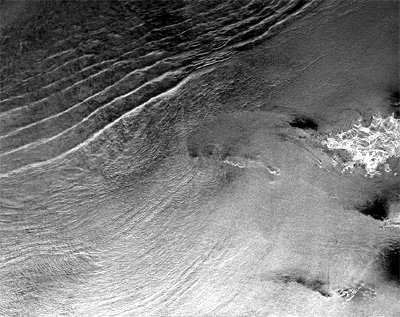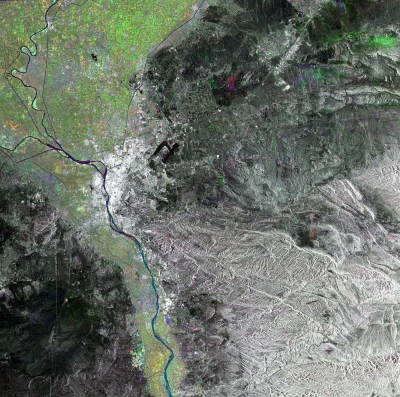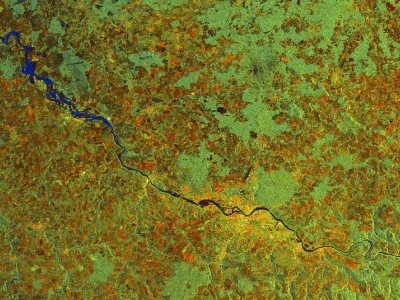ASAR Applications
The ASAR instrument aboard Envisat mainly supported ocean, land, and snow and ice land applications. The instrument was also used to monitor natural disasters. A brief overview of ASAR applications is presented below. More information can be found in the ASAR Product Handbook.
Oceans

of the Andaman Sea, acquired on 23 January 2006.
The oceans not only provide valuable food and biophysical resources, they also serve as transportation routes, are crucially important in weather system formation and CO2 storage, and are an important link in the Earth's hydrological balance. Understanding ocean dynamics is important for fish stock assessment, ship routing, predicting global circulation consequences of phenomena such as El Niño, forecasting and monitoring storms so as to reduce the impact of disaster on marine navigation, offshore exploration, and coastal settlements. Studies of ocean dynamics include wind and wave retrieval (direction, speed, and height), mesoscale feature identification, bathymetry, water temperature, and ocean productivity.
A number of different methods for acquiring information on the open ocean and coastal regions have been possible with remote sensing. In particular, the ASAR instrument provided new SAR ocean applications, notably in the areas of pollution monitoring, ship detection, and ocean feature nowcasting (while operational). This information was useful for offshore engineering activities, operational fisheries surveillance, and storm forecast operations.
Some of the key areas of interest include the following:
- Wave Characteristics
- Ocean Fronts
- Coastal Dynamics
- Oil Slicks and Ship Traffic
Land

Land cover is defined as the observed physical cover, including vegetation and human constructions, of the Earth's surface. Radar data can be used in a number of applications supporting land cover delineation, base mapping and updating, and environmental monitoring. Radar data is used as a tool for distinguishing differences in surface roughness, moisture content, and geometric shape associated with different land uses and covers, which in turn allows the delineation and identification of land cover types and related land use and cultural features.
In particular, the ASAR sensor has been used for numerous land-based applications, which included:
- Global Vegetation Monitoring
- Forestry
- Geology and Topography
- Agriculture
- Natural Hazards
- Flooding, Hydrology and Water Management
- Urban Studies
Natural Disasters

showing the flood extent of the River Elbe, including Dresden.
Natural hazards such as earthquakes, floods, drought or landslides can set back economic development in the affected countries for many years. Therefore, disaster reduction measures are essential component of sustainable development policies and programmes. With remote sensing data it is possible to estimate and measure the various phenomena in relation to surface movements (such as earth quakes), water (floods, tsunamis, storms etc.) and fire (forest fires).
A number of areas of study relating to natural hazards utilised ASAR data. These include:
- Volcanic activity
- Earthquakes
- Land subsidence
- Flooding
Snow and Ice

in the Canadian Arctic Archipelago
There is a wide range of sea ice data applications in the marine community and across a number of industrial sectors. Industries and agencies operating in ice-infested waters include commercial shippers, offshore oil exploration companies, fisheries, military, regulatory agencies, and research institutions. Other industrial sectors use ice information when designing ship hulls and offshore drilling platforms, to perform risk assessment, and to establish insurance premiums. SAR data are combined with other sources of data to optimise sea ice forecasts, and are also transmitted directly to ice breakers and ships operating near the ice edge.
The sea ice markets include agencies in the USA, Canada, Japan, Russia, Norway, and the Baltic countries. SAR data are combined with other sources of data to optimise sea ice forecasts, and are also transmitted directly to ice breakers and ships operating near the ice edge.
ASAR data has been used in areas of study such as:
- Ice concentration determination
- Sea ice mapping and classification
- Ice feature identification
- Sea ice motion monitoring
- Iceberg tracking
- Ship routing through sea ice
- Ice sheet dynamics
- Snow cover